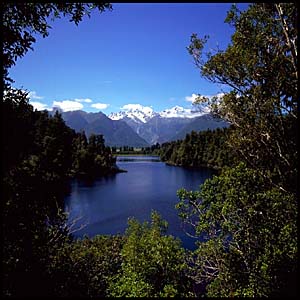 New Zealand lies between 34 and 47 degrees south latitude and consists
of two long, narrow main islands, North Island (114,500 square km) and
South Island (150,700 square km). North Island, with its golden beaches,
ancient kauri forests, lakes, volcanos, thermal areas, and large cities
(including Wellington, the capital), is the more densely populated. South
Island, with its snowcapped mountains, glaciers, lush native bush, and fiords,
is the larger of the two, proudly called "the mainland" by residents (though
North Islanders are quick to disagree!). Tiny Stewart Island (1,750
square km), an unspoiled, bird-filled bush and beach paradise at the foot of
the South Island, is the closest most people ever get to the Antarctic. Also
within New Zealand's territorial jurisdiction lie several small island groups,
including the Chatham, Kermadec, and Tokelau Islands, Campbell
Island, Auckland, Antipodes, Snares, Solander, and Bounty Islands,
and Ross Dependency, Antarctica.
New Zealand lies between 34 and 47 degrees south latitude and consists
of two long, narrow main islands, North Island (114,500 square km) and
South Island (150,700 square km). North Island, with its golden beaches,
ancient kauri forests, lakes, volcanos, thermal areas, and large cities
(including Wellington, the capital), is the more densely populated. South
Island, with its snowcapped mountains, glaciers, lush native bush, and fiords,
is the larger of the two, proudly called "the mainland" by residents (though
North Islanders are quick to disagree!). Tiny Stewart Island (1,750
square km), an unspoiled, bird-filled bush and beach paradise at the foot of
the South Island, is the closest most people ever get to the Antarctic. Also
within New Zealand's territorial jurisdiction lie several small island groups,
including the Chatham, Kermadec, and Tokelau Islands, Campbell
Island, Auckland, Antipodes, Snares, Solander, and Bounty Islands,
and Ross Dependency, Antarctica.
Surrounded by the South Pacific Ocean on the east and the Tasman
Sea on the west, New Zealand appears to be a mere speck on the globe, and yet
it's about 1,770 km from top to bottom--similar in size to the British Isles or
Japan. Australia, 2,092 km northwest, is New Zealand's closest neighbor, and
because of this relative proximity the two countries are often mistakenly
believed to be one. But beware! To innocently suggest this to "Kiwis" (as New
Zealanders like to call themselves) is to risk running afoul of their good
natures. New Zealand is an independent self-governing nation.